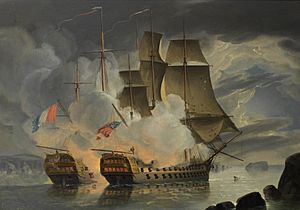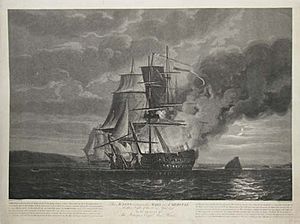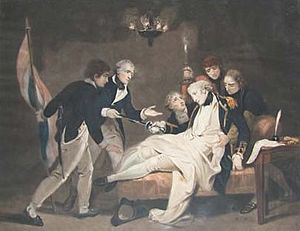Battle of the Raz de Sein facts for kids
Quick facts for kids Battle of the Raz de Sein |
|||||||
|---|---|---|---|---|---|---|---|
| Part of the French Revolutionary Wars | |||||||
 The furious action between H.M.S. Mars and the French '74 Hercule off Brest on 21st April 1798, John Christian Schetky |
|||||||
|
|||||||
| Belligerents | |||||||
| Commanders and leaders | |||||||
| Strength | |||||||
| 1 ship of the line | 1 ship of the line | ||||||
| Casualties and losses | |||||||
| 90 killed and wounded | 290 killed and wounded 1 ship of the line captured |
||||||
The Battle of the Raz de Sein was a naval battle between two large warships. It happened on April 21, 1798, during the French Revolutionary Wars. The British Royal Navy was blocking the French port of Brest.
A British fleet, led by Admiral Lord Bridport, was sailing near Brest. On April 21, they saw some ships in the distance. Three British ships, including the large 74-gun HMS Mars led by Captain Alexander Hood, went to chase them.
Then, they saw another ship, a big one, sailing near the coast. This was the 74-gun French ship Hercule. It was new and sailing to Brest to join the main French fleet. The British ships immediately changed course to catch Hercule.
Captain Louis Lhéritier of Hercule tried to escape through a narrow passage called the Raz de Sein. But the ocean current was against him. So, he anchored his ship at the entrance of the passage, ready to fight. At 9:15 PM, Mars reached Hercule. Captain Hood bravely steered his ship right next to the French vessel.
For over an hour, the ships fired their cannons at each other. They were so close that the guns had to be fired from inside the ships. Both ships were badly damaged. Many sailors were hurt or killed. Captain Hood was sadly wounded during the fight and later died.
Finally, Hercule had to surrender after its crew failed to board Mars. Both ships were burned and damaged. The French had about 290 casualties, and the British had 90. Hercule was taken to Britain, repaired, and served in the British Royal Navy. Both captains were praised for their bravery. This battle was special because it was a fair fight between two equally strong ships.
Why the Battle Happened
During the French Revolutionary Wars, the Royal Navy was very strong at sea. They often fought the French Navy. The main French fleet was based at Brest. To keep the French fleet from leaving, the British kept a close watch on Brest. This was called a blockade.
The blockade stopped French ships from trading and communicating. They attacked merchant ships and warships trying to reach Brest. This made sea travel very risky for the French. For example, in 1795, the French fleet lost a battle near Lorient. In 1797, another French ship was destroyed near Brest.
On April 12, 1798, the British blockade fleet, led by Admiral Lord Bridport, sailed to the French coast. He had ten large warships. The French Navy had lost many ships in earlier battles. To replace them, they were building new ships. In April 1798, a new ship called Hercule was ready. It was a 74-gun ship, commanded by Captain Louis L'Héritier. He was an experienced officer.
The Chase Begins
On April 20, Captain L'Héritier was ordered to take Hercule on its first trip. The journey was short, along the coast to Brest. There, more sailors would join the crew. Hercule also carried extra supplies for other ships. L'Héritier's crew was new and not very experienced. He planned to stay close to the coast.
But as his ship sailed across Audierne Bay, he saw ships in the distance. These were three British ships from Lord Bridport's fleet. At 11:00 AM on April 21, the British fleet was sailing when they saw two ships to the east. Lord Bridport sent three of his ships to investigate. These were the 74-gun HMS Mars (Captain Alexander Hood), HMS Ramillies (Captain Henry Inman), and the 38-gun frigate HMS Jason (Captain Charles Stirling).
The strong winds helped the large British ships chase the French ships. At 2:00 PM, they were catching up when they saw a third, much larger ship. This new ship was Hercule. The British squadron immediately changed direction to chase Hercule.
By 5:45 PM, L'Héritier was trying to escape. The British ships were spread out behind him. Jason was in the lead, with Mars close behind. Captain Hood, an experienced officer, pushed Mars forward. He gradually gained on both Jason and Hercule. L'Héritier knew he would be caught in open water. He tried to escape through the dangerous Raz de Sein channel. This channel was known for shipwrecks.
As Hercule neared the channel, Mars moved to cut her off. At 8:30 PM, L'Héritier realized the current was too strong for Hercule to go through the channel. So, he anchored his ship at the mouth of the channel. He prepared his ship to face the British attack.
The Fierce Fight

At 8:45 PM, Mars tried to get into a good position to attack Hercule. But the strong currents in the Raz de Sein made it hard for Captain Hood to control his ship. So, he decided to bring Mars right next to Hercule and fight side-by-side.
At 9:15 PM, Mars was close enough. L'Héritier opened fire, and Hood fired back immediately. For ten minutes, Mars's masts and ropes were hit. Hood kept trying to hold his position against the current. Then, at 9:25 PM, Mars pulled slightly ahead and dropped anchor. The anchor rope got tangled with Hercules anchor. This pulled Mars violently into the French ship. Four of Marss gun openings were broken.
With the ships locked together, both captains ordered their crews to fire. They were so close that many cannons could not be fully extended. They had to be fired from inside the ships. The heat from the constant firing was so intense that the wood started to burn. Cannonballs tore huge holes in the sides of both ships. Hercule's side was so damaged that the wood between the gun openings was ripped away.
Many sailors were hurt or killed on both sides. Twenty minutes after the fight began, a musket ball hit Captain Hood in the leg. He was badly wounded and bleeding a lot. Hood was carried below deck, and Lieutenant William Butterfield took command. The French had many more casualties than the British. This was because Hood's trained crew fired their cannons much faster.
Captain L'Héritier knew his ship was suffering more. He ordered his men to try and board the British ship. But two attempts to board Mars failed. The French crew had lost their lighting at the start of the battle, making them confused. Only about 40 men joined L'Héritier's boarding attempt. He was injured twice himself while leading the attack.
At 10:30 PM, after an hour of constant firing, L'Héritier surrendered. Hercule's hull was torn open. Five of its guns were broken, and over two-fifths of the crew were killed or wounded. Jason was getting close, and the rest of the British fleet could see the flashes from the battle.
What Happened Next

L'Héritier gave his sword to Lieutenant Butterfield as a sign of surrender. It was then given to the dying Captain Hood, who accepted it before he passed away. At 10:50 PM, Jason arrived. Captain Stirling took charge of moving the French prisoners from Hercule. He then began the difficult task of moving the two damaged warships out of the dangerous Raz de Sein channel.
The exact number of French losses was not fully recorded. Some reports said as many as 400, but a more realistic number was 290 killed or wounded. British losses were 22 killed and 60 wounded. Eight men were missing, believed to have drowned. Luckily, the weather was calm. Neither Mars nor Hercule could have survived a storm. With great care, Hercule was brought to Plymouth on April 27. Repairs began to get the ship ready for service again. The repairs cost a lot of money, but HMS Hercule joined the Royal Navy and served until 1810.
Historians say this "classic fight" was special. It was a rare battle between two single warships of equal strength. They fought without any outside help. Both ships were very similar in size and power. The British ship Mars had a slight advantage because its crew was more experienced. But historians agree that both sides fought bravely.
Even though some British stories said L'Héritier died from his wounds, this was not true. When he returned to France after being exchanged, he faced a military trial for losing his ship. But he was found innocent and praised for his strong resistance. In Britain, Lieutenant Butterfield was promoted. Captain Hood was honored after his death. Admiral Bridport wrote that Hood's bravery was outstanding. Hood's body was returned to England and buried near his home.

